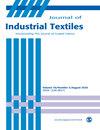Bio-leather: Sustainable clothing fabrics made from simple media ingredients and slime mold Physarum polycephalum
IF 2
4区 工程技术
Q1 MATERIALS SCIENCE, TEXTILES
引用次数: 0
Abstract
The textile industry contributes significantly to global warming and pollution, especially the leather industry, which uses livestock and toxic tanning processes that have a great environmental impact. Currently, efforts are being made to mitigate the negative impacts of the textile industry by using alternative non-toxic chemicals or by recycling fabric. More recent efforts explore utilization of non-conventional biomaterials and organisms, such as mushroom mycelia, algae or genetically-engineered microorganisms. In this study, we implemented slime mold Physarum polycephalum perfused through leather-like fabrics made from air-dried simple nutritious media in order to develop environmentally friendly, easy-to-manufacture and sustainable fabrics. Plasmodium was validated for its viability and propagation under non-sterile conditions and in contaminated environments on different media compositions made from agar, peach gum, gelatin, carrageenan or glycerol. We determined optimal media components to be agar, gelatin and glycerol which supported plasmodium growth and yielded sturdy and flexible fabric sheets after air-drying. Ultimately, plasmodium-perfused fabric sheets were sewed into apparel and footwear. This study demonstrates the use of simple media as a clothing fabric perfused with plasmodium, which produces intricate colors and patterns on the fabric. Plasmodium has the ability to enhance fabric properties due to its natural problem-solving abilities, such as biosensing, fabric self-repair, and distant fabric communication.生物皮革:用简单的介质成分和粘菌 Physarum polycephalum 制作的可持续服装面料
纺织业是造成全球变暖和污染的重要因素,特别是皮革业,它使用牲畜和有毒的鞣革工艺,对环境造成极大影响。目前,人们正在努力通过使用替代性无毒化学品或回收织物来减轻纺织业的负面影响。最近,人们开始探索利用非常规生物材料和生物体,如蘑菇菌丝体、藻类或基因工程微生物。在这项研究中,我们利用粘菌多头瘤灌注到由风干的简单营养培养基制成的皮革状织物中,以开发环保、易制造和可持续的织物。我们对疟原虫在非无菌条件下和污染环境中,在由琼脂、桃胶、明胶、卡拉胶或甘油制成的不同培养基成分上的存活和繁殖情况进行了验证。我们确定琼脂、明胶和甘油为最佳培养基成分,它们能支持疟原虫生长,并在风干后产生坚固而有弹性的织物薄片。最终,疟原虫浸渍织物片被缝制成服装和鞋类。这项研究表明,使用简单的介质作为灌注疟原虫的服装织物,可以在织物上产生复杂的颜色和图案。疟原虫具有自然解决问题的能力,如生物传感、织物自我修复和远距离织物通信,因此有能力增强织物的特性。
本文章由计算机程序翻译,如有差异,请以英文原文为准。
求助全文
约1分钟内获得全文
求助全文
来源期刊

Journal of Industrial Textiles
MATERIALS SCIENCE, TEXTILES-
CiteScore
5.30
自引率
18.80%
发文量
165
审稿时长
2.3 months
期刊介绍:
The Journal of Industrial Textiles is the only peer reviewed journal devoted exclusively to technology, processing, methodology, modelling and applications in technical textiles, nonwovens, coated and laminated fabrics, textile composites and nanofibers.
 求助内容:
求助内容: 应助结果提醒方式:
应助结果提醒方式:


